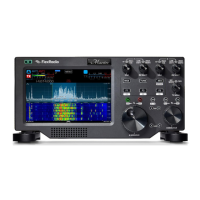FLEX-6000 Signature Series – Maestro User Guide
Copyright 2024 FlexRadio, Inc. All Rights Reserved. | Page 66
Given the wideband nature of this feature, the threshold slider controls an entire Panadapter,
which may have several Slice Receivers attached to it. This means that the WNB can positively
impact not only the audio of Slice Receivers but also the panafall visual display. For convenience,
the slider is available in each Slice and each Panadapter. Adjusting any one of them adjusts an
entire Panadapter, and all related slider controls are updated. Enabling and disabling the WNB
function is available separately for each Panadapter.
When the WNB detects a significant change in signal level or bandwidth, it attempts to normalize
the slider value. During this time, blanking will be momentarily bypassed, and the WNB indicator in
the Panadapter will start to flash (blink). Once a suitable normalized slider range has been re-
established, the noise blanking action will resume, and the WNB indicator will return to a solid
color.
It is possible for certain WNB-level settings to distort with certain types of signals. For example, in
the proximity of very large signals, noise may become worse with aggressive settings of WNB. If this
is the case, either lower the WNB level setting or disable WNB on that Panadapter.
14.4 SLICE SPECIFIC NOISE BLANKER (NB)
The Slice Specific Noise Blanker (NB) is used to combat fast rise time pulse-type noise such as
power line hash and car ignitions, on an individual Slice Receiver basis. To enable the Noise
Blanker, tap the NB button in the Slice Receiver Menu, then adjust the threshold control for the
best noise suppression. In general, the default setting is adequate, but depending on the noise
characteristics, some adjustments can help. The NB Threshold control adjusts the level at which a
sample is considered to be impulse noise. The general rule of thumb for this adjustment is to use
the lowest level that is effective. For large impulse noise (meaning the noise floor jumps are large) a
lower level should be used. If the impulse noise is causing only small jumps in the noise floor, a
higher level can be used.
Unlike the Wideband Noise Blanker, the Slice Specific Noise Blanker algorithm considers only 24kHz
of the RF spectrum, centered on the Slice Receiver’s tuned frequency, not the entire SCU RF
spectrum, as is the case with WNB. The NB algorithm complements the WNB algorithm and may be
used with or without WNB. It may be more effective than WNB, less effective, or do not affect
specific examples of impulse noise. The Slice Specific Noise Blanker may be turned on or off and
adjusted for each Slice Receiver.
14.5 NOISE REDUCTION (NR)
The Noise Reduction processor (NR) will reduce random (“white”) noise making signals more
readable which are buried in the noise. It is best to adjust the AGC threshold first, and then enable
the Noise Reduction.
The Noise Reduction algorithm uses a correlation-based adaptive filter. Noise Reduction increases
the correlation between input and output with the assumption that noise is uncorrelated and
should be canceled out. The threshold adjustment controls the adaptation rate of the filter, so in
the case of Noise Reduction, there will be very little audible change while adjusting the threshold
unless the noise is changing rapidly or dramatically. The most aggressive settings of Noise
Reduction increase the signal-to-noise ratio but will tend to “color” the signal. The slider should be
set for the optimal tradeoff between signal-to-noise ratio and minimal distortion of the desired
signal.

